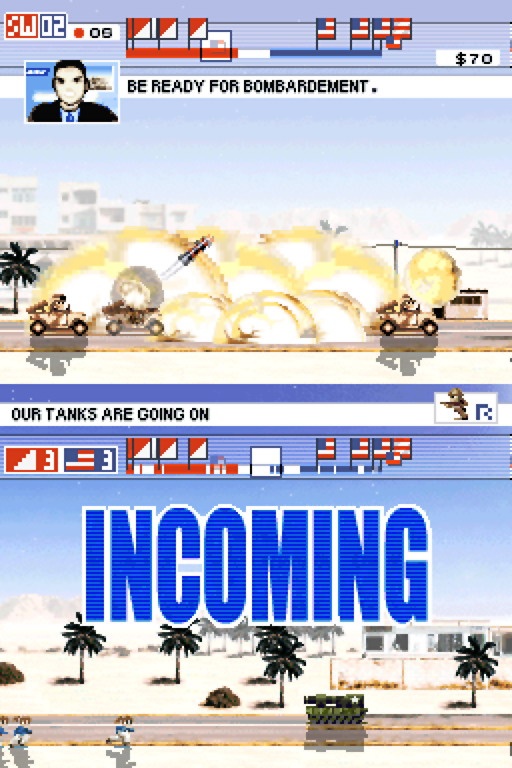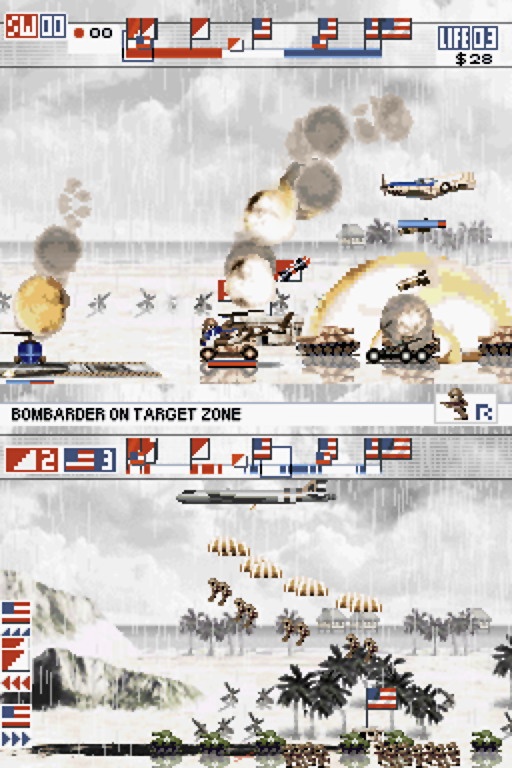Glory Days 2, the sequel to a Game Boy Advance game that was released here in the US as Super Army War, whips together a light blend of 2D side-scrolling shooter action, tactical combat, and modern real-time strategy convention into something that feels simultaneously unique and familiar. For the most part, the action and the strategy are never terribly taxing, but the constant juggle between deploying units, capturing bunkers, rescuing civilians, and raining death from above onto enemy forces keeps the game constantly engaging.
The loose narrative, which sees you fighting as a procession of pilots fighting different wars during different eras, is driven by written correspondence between your soldier and his loved ones back home. There's a natural quality to the writing in the letters, which see the characters go through a range of emotions as they progress from mission to mission. They share feelings of dread, longing for home, a steeled determination to do what's right, and anecdotes about their day-to-day lives and their comrades. There are occasions of overly politicized heavy-handedness over the cost of war and the relative value of the opinions of those who aren't on the frontlines, but for the most part it's a disarmingly effective device.

Though you'll fight across sandy beaches, snowy mountains, the sun-bleached desert, lush plains, and city streets, the battlefield in Glory Days 2 is invariably a long, flat, horizontal stretch of road. At either end, you'll find your base, as well as your enemy's base. In between you'll find bunkers, gunner positions, and civilians caught in the middle of your military quagmire. Depending on the mission, you have direct control over either a plane or a helicopter, and which one you're given has a significant impact on the feel of the mission. Both have air-to-air artillery and air-to-ground payloads. The planes benefit from speed and a certain maneuverability, while the choppers can change direction more easily, can be landed in the middle of the battlefield to rescue civilians, and can be used to pick up soldiers at your base and deploy them in the field. Their relative flexibility end up making the chopper missions inherently more fun.
Rescuing civilians--be it by chopper or ambulance--and deploying troops on the battlefield are important, because civilians that you're able to pluck from the field and shepherd to safety translate directly into cash, and troops can take up position inside empty bunkers, which provide a regular revenue stream. All of this cash is then used to deploy troops, tanks, antiaircraft jeeps, and ambulances, and your ground forces are key to victory. While you're flying overhead, bombing enemy-held bunkers and the never-ending procession of enemy vehicles, your ground forces are marching along, engaging whatever enemy forces happen to be coming from the opposite direction. You're essentially fighting a huge, militarized game of tug-of-war, and victory is invariably had by pushing enemy forces all the way back to their base on the other side of the field, and destroying it.
Though you'll be focusing on the air unit that you have direct control over on the top screen, you've got several good tools to keep you abreast of the situation elsewhere on the battlefield. A distilled map of the battlefield makes it easy to figure out, at a glance, your forces' progress on the battlefield, your current position, and which bunkers are controlled by which army, while the lower screen tracks whatever units are on your frontlines. It's easy to deploy units on the fly, and once they're on the ground, you don't really need to worry about them again. They'll just truck along, doing what they're programmed to do. The game will also deploy troops and vehicles for you automatically, should you get too caught up in the action, though if you neglect any one part of the game for too long, you will invariably find yourself overwhelmed. When you know the strengths and weaknesses of your units, you'll find specific deployment patters that help increase their survival rates. Even then, a huge percentage of your units invariably end up as cannon fodder, and it's not uncommon to deploy several hundred units over the course of a mission.

As you progress through the game, you'll gain access to special attacks like air strikes, as well as more advanced military hardware. At the same time, your enemy's units will get stronger, faster, and smarter, and while it can be a challenge, it never really becomes unmanageable. The biggest shortcoming in Glory Days 2 is the relative brevity of the campaign, which can be torn through in a few hours. There are other ways to play, including a skirmish mode where you can define an incredible number of variables, and a local multiplayer mode that supports up to eight players at once, but it's hard not to wish the campaign would keep going for at least a little while longer.
There are shades of Advance Wars to the presentation in Glory Days 2, specifically in the way it depicts anime-style soldiers fighting in a violent but oddly bloodless war, but the overall tone here is much more somber and serious. The soundtrack consists of just a few huge, sweepingly righteous orchestral compositions that bring an unflinching grandeur to your constant march toward victory. The look of the units errs toward realistic, though the generally zoomed-out camera perspective keeps you from seeing too much detail. Where the visuals really shine are in the environments, which are packed with detail and a number of scrolling background layers that provide a level of depth that almost rivals actual 3D graphics. Touches like the way you can see wind whipping past you as you speed across the battlefield, nice-looking weather effects, and the odd scan-line flicker of night vision when you're fighting in the dark bring a sense of heightened realism to the visuals.
As commonplace as the components are, Glory Days 2 adroitly assembles them into something pretty rare. It's lamentable that the campaign is as short as it is, but it's not enough to keep the rest of the game's unique charms from shining through.